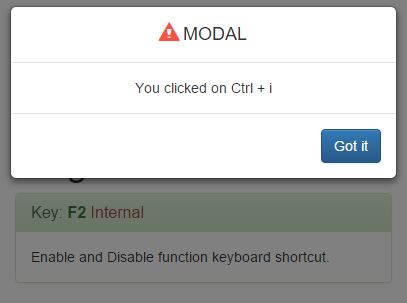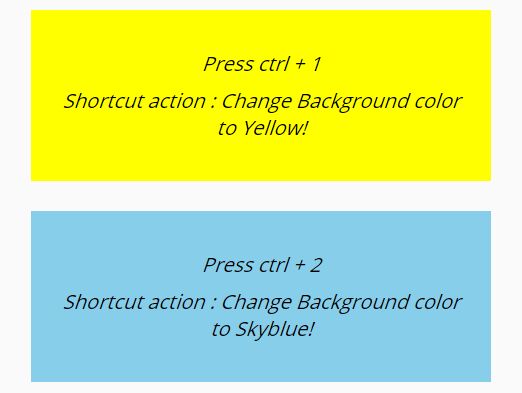
If no handlers are given, remove all handlers for that key. Remove handlers for a shortcut given by key. Other valid events are keyup and keypress. As of version 1.1.0, you can prepend the desired event type to your key using the colon character, e.g. See John Resig's hotkeys plugin for more information on the format. To bind Ctrl + c to a function ( f ), for example: (document).bind keydown, ctrl+c, f) Share Improve this answer edited at 22:45 Dave Jarvis 29.
#Jquery shortcat code
Note that priorities are only applied, when the priorities option is set to true.Īdd handlers for a shortcut given by key. What about jQuery Hotkeys jQuery Hotkeys lets you watch for keyboard events anywhere in your code supporting almost any key combination.

Otherwise, the current priority is returned. When priority is given, the priority is set to that value. Note that in case the parent is disabled, this shorcuts do not fire even if they are enabled!ĭisable the shortcuts. Return a child shortcut group given by name.Įnable the shorcuts. Return all child shortcut groups mapped to their names. Returns the parent shortcuts, or null when invoked on the global shortcut group. Note that the global namespace ( "global" in this example) is always prepended. Example: namespace "foo.bar" => shortcuts "global" -> shortcuts "foo" -> shortcuts "bar". A namespace consists of a number of names seperated by a delimitter. When no argument is given, the global shortcut group is returned. If a namespace is passed, a new shortcuts instance/group with that namespace is created and returned. Dependencies This jQuery plugin requires John Resig's hotkeys plugin to be loaded. You can even manage parentage of shortcut groups via namespaces. If options are passed, the global options are extended and the $.Shortcuts object is returned. jQuery.Shortcuts lets you easily switch between sets (groups) of arbitrary and easy-to-define shortcuts. priority ( 10 ) // // no, when ctrl+h is pressed, only sc2 fires // API add ( "ctrl+h", handler ) // assign a higher priority for sc2 (default is 0) sc2. ('test').hide () - hides the element with id'test'. ('.test').hide () - hides all elements with class'test'. If you can use them or one of them, you should use them/it as far as possible.// configure the plugin $. A ( selector) to 'query (or find)' HTML elements A jQuery action () to be performed on the element (s) Examples: (this).hide () - hides the current element. Also, Google Chrome and Safari support KeyboardEvent.keyIdentifier which is defined in the old draft of DOM Level 3 Events. IE and Firefox already (partially) support KeyboardEvent.key. This shouldn't be used by new web applications. Pages or Web apps using it may break at any time. Though some browsers may still support it, it is in the process of being dropped. This feature has been removed from the Web standards.

Quoting MDN article for ke圜ode: Deprecated Ke圜ode has recently been deprecated (but I haven't found a cross-browser solution yet).


You can use this jQuery code to capture the keydown event of the left, right, up, and down arrow keys:Į.preventDefault() // avoid browser scrolling due to pressed keyĪnd in the following code snippet you can see and run a complete example in which images are swapped using the keys or the buttons. At this moment the other 3 answers here use this keypress event and that is why they don't work in Google Chrome nor Safari, but if you change that to keydown they'll work on all browsers. That is why that is not useful for trapping any key alone.īut you have to take special care choosing the event to trap the cursor keys because Webkit has decided not to trap them with the keypress event as it is not in the standard. As zzzzBov explained, the HTML accesskey defines a key that will be trapped only when it is combined with the ALT key.


 0 kommentar(er)
0 kommentar(er)
